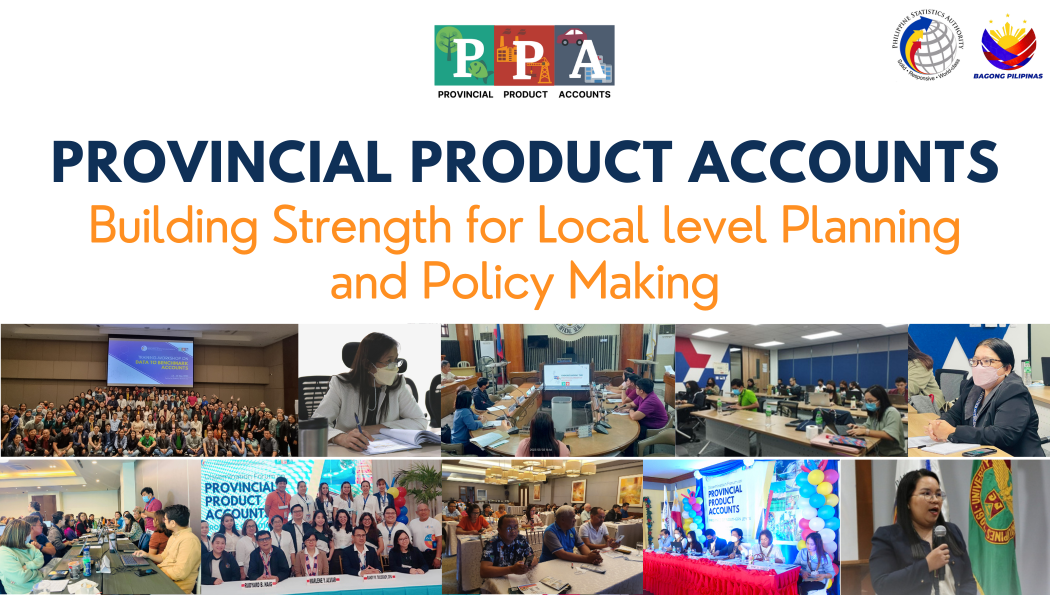Provincial Product Accounts (PPA)
2018 to 2020 Economic Performance of Cebu Province
Release Date:Reference Number: 2022-SR22-001The Economy of Cebu Province declined by 8.9 percent in 2020
The economy of Cebu Province declined by 8.9 percent in 2020. The total amount of goods and services produced by the province in 2020 was valued at PhP 348.2 billion, this represents a decline of 8.9 percent from the PhP 382.2 billion produce in 2019 while in 2018 it was valued at PhP 364.9 billion. (See Figure 1)
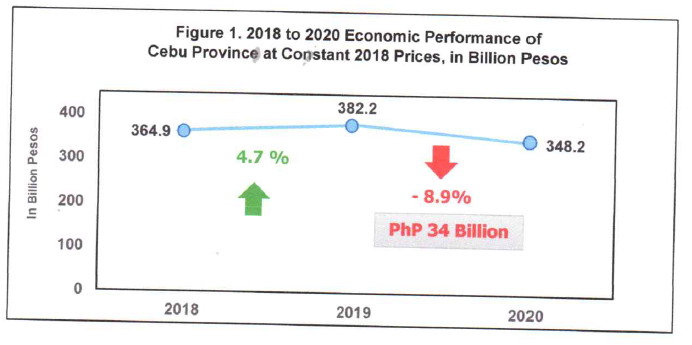
Percentage share of Industries of Cebu Province
The province economy is driven by the following industries: Manufacturing, Wholesale and Retail Trade; Repair of Motor Vehicles and Motorcycles, and Real Estate and Ownership of Dwellings based on the 2018 to 2020 annual average share of 17.6 percent, 13.7 percent, and 11.5 percent respectively.
In 2020, Agriculture, Forestry and Fishing maintained positive growth of 4.0 percent from 3.7 percent in 2019. Industry and Services posted negative growth of 17.9 percent and 5.5 percent respectively. Moreover, five industries posted positive growth, namely; Agriculture, Forestry, and Fishing with 4.0 percent, Electricity, Steam, Water and Waste Management with 5.9 percent, Wholesale and Retail Trade; Repair of Motor Vehicles and Motorcycles with 0.2 percent, Information and Communication with 12.6 percent, and Financial and Insurance Activities with 9.1 percent.
(See Table 1).
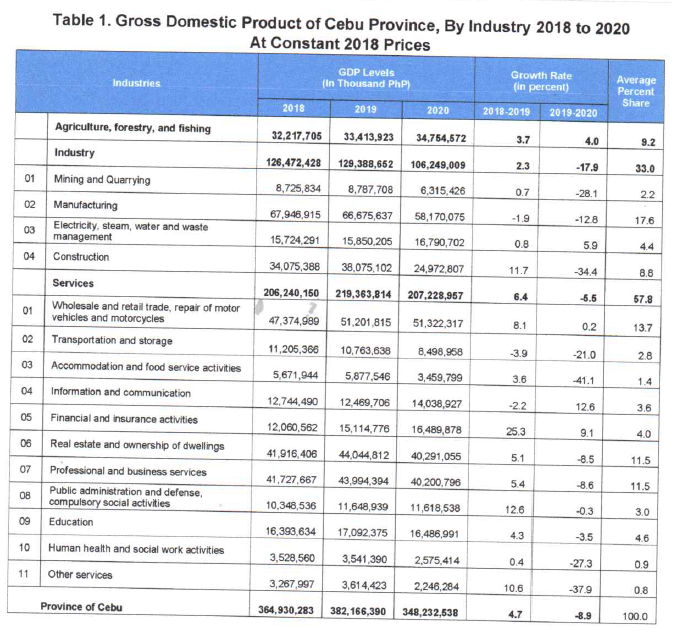
Cebu Province is mainly driven by Services among major industry
Services has the largest share of the province economy accounting to 57.8 percent. This is followed by Industry with 33.0 percent and Agriculture, Forestry and Fishing taking 9.2 percent. (See Figure 2)
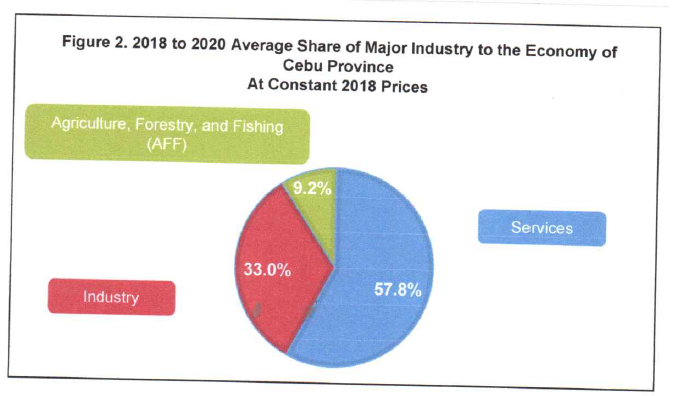
Contribution of each industry to the total economy of Cebu Province
For the contribution of each industry to the total economy of Cebu Province; in 2019; Services shared 3.6 percentage points to the 4.7 percent increase in 2019. Industry shared 0.8 percentage points and Agriculture, Forestry, and Fishing (AFF) managed to contribute 0.3 percentage point. Meanwhile, in 2020; Services shared a negative 3.2 percentage points to the 8.9 percent decline in 2020. Industry shared -6.1 percentage points while Agriculture, Forestry, and Fishing managed to share the only positive percentage points at 0.4. (See figure 3)
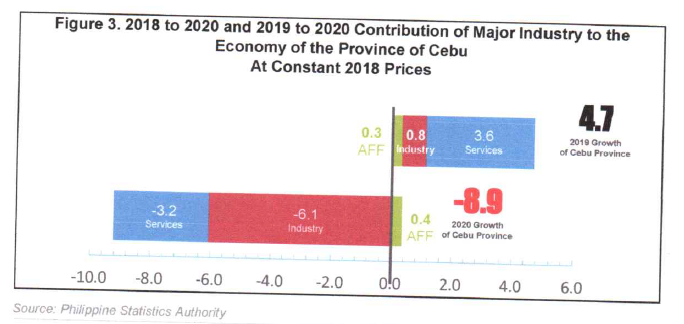
Per Capita Gross Domestic Product of Cebu Province
In 2018, the Per Capita Gross Domestic Product (GDP) of Cebu is at PhP 116,388 while in 2019 it was estimated at PhP 119,498 and in 2020 at PhP 106,867. (See Figure 4)
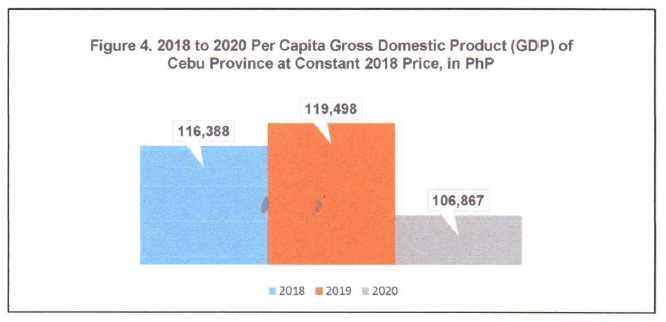
Manufacturing has the largest percentage share of 53.2 percent among Industry
Among Industry, Manufacturing has the largest share of 53.2 percent, followed by Construction with 26.8%, Electricity, Steam, Water, and Waste Management with 13.4 percent, and Mining and Quarrying with 6.6 percent share in 2018 to 2020. (See Figure 5)
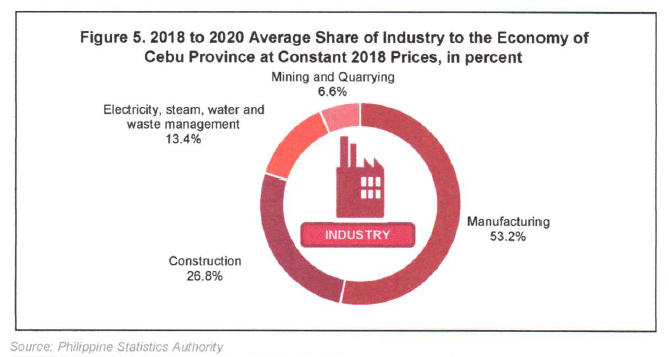
Wholesale and Retail Trade and Repair of Motor Vehicles and Motorcycles has the largest percentage share of 23.7 percent among ServicesAmong Services, Wholesale and Retail trade; Repair of Motor Vehicles and Motorcycles had the higher share of 23.7 from 2018 to 2020. This was followed by the Real Estate and Ownership of Dwellings with 20.0 percent Professional and Business Services and with 19.9 percent Education with 7.9 percent, Financial and Insurance Activities with 6.9 percent. Information and Communication with 6.2 percent, Public Administration and Defense, Compulsory Social Activities with 5.3 percent, Transportation and Storage with 4.8 percent, Accommodation and Food Services Activities with 2.4 percent, Human Health and Social Work Activities contributed 1.5 percent, and Other Services with 1.4 percent to the Service sector. (See Figure 6)
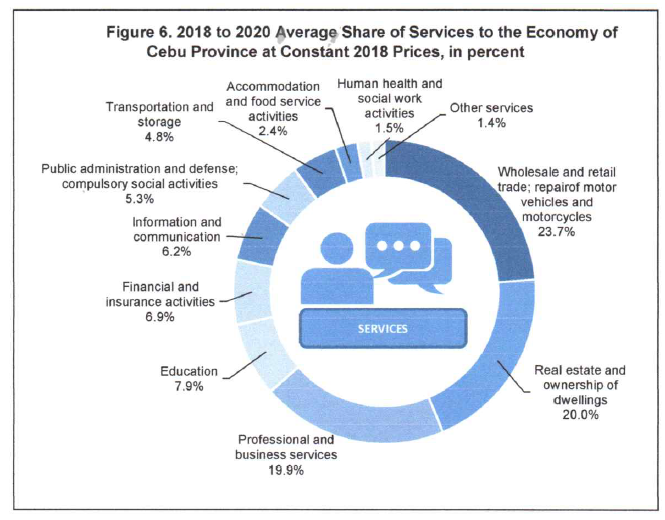
Technical Notes:
Provincial Product Accounts (PPA) - is a tool used to measure the economic performance of the province or highly urbanized cities (HUCs) at a given time. It monitors the economic development of the province/HUC and evaluates the progress through time. It also serves as a metric to identify which sector or industry that needs intervention for its sustainability in the province’s economy. PPA intends to strengthen the planning and decision-making of provincial policymakers and stakeholders in crafting more informed economic policies and programs.
Gross Domestic Product (GDP) - is a monetary measure of the market value of all the final goods and services produced in a specific time period.
Measuring the Economic Performance
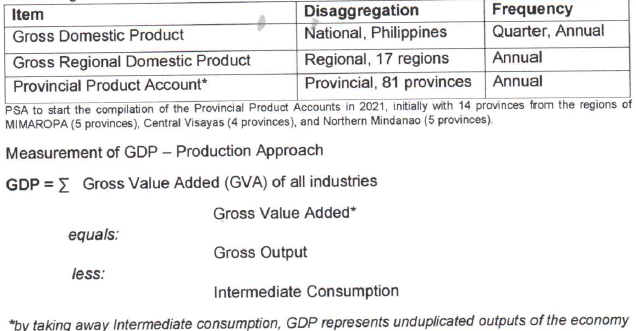
Approved by:
(SGD) FIRMO C. DIPUTADO
Chief Statistical SpecialistAttachment Size  2022-SR22-001.pdf
2022-SR22-001.pdf1.13 MB



